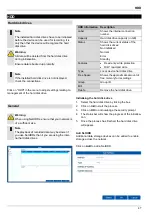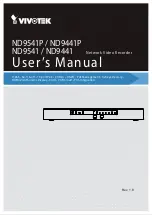
Camera
42
VCA
Select the camera channel to be processed under "Cam-
era".
Then, if your camera model supports the functions, you
can configure one of the following VCA (video content
analysis) functions.
VCA
Function
Face Detection
Face Detection
Tripwire detection
Triggers recording when a
drawn line is crossed
Intrusion Detection
Triggers recording when an
object is present in a drawn
area for longer than a cer-
tain amount of time
Defocus Detection
Triggers recording in the
event of defocus detection
Scene Change Detec-
tion
Triggers recording in the
event of tampering through
scene changes
PIR Alarm
Triggers recording when a
PIR sensor is detected
The VCA functions can be used in a similar way to mo-
tion detection or alarm inputs as triggers for further ac-
tions in the NVR (e.g.: recording, email, alarm outputs
etc...)
Select the required VCA function to start configuration.
Different settings options are available for different VCA
functions. Here is a summary of the parameters:
Option
Description
Enable
Enables the VCA function in
the camera.
Settings
Define settings for re-
sponses in the event that an
alarm is triggered (email,
notification of Surveillance
Centre etc.)
Rule
Select the number of rules.
Depending on the function,
several rules can be config-
ured simultaneously.
Rule Settings
Select the sensitivity set-
tings for the function (e.g.:
object size, direction, dwell
time).
Draw Line
Draw line for tripwire. The
line is created by positioning
two points on the live im-
age.
Draw Quadrilateral
Draw area (quadrilateral) for
intrusion detection. The
area is created by position-
ing four points.
Clear All
Deletes all lines/areas of the
currently selected rule.
To fully enable the VCS function, confirm all settings by
clicking on
Apply
.
Note
Further information on the descriptions and uses
of the VCA functions can be found in the camera
user guide.
Some VCA functions may not be available, de-
pending on the camera model used.
Note
Not all VCA functions have freely configurable
"rules" (lines, areas).
After all the VCA functions have been set, this
data is transferred to the IP camera. Analysis of
the VCA data takes place in the camera only. The
camera then transfers the VCA results only as
"meta-data" to the NVR.
















































